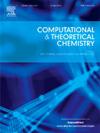熔融AlCl3-MCl (M = Li, Na, K)体系中物质的热力学和量子化学计算
IF 3
3区 化学
Q3 CHEMISTRY, PHYSICAL
引用次数: 0
摘要
霍尔-海姆法在铝生产中占主导地位,但能源需求高且污染严重。本研究通过量子计算和数学建模,分析了AlCl3-MCl (M = Li, Na, K)熔盐在373-473 K和933-1033 K下的物质行为,研究了氯化铝工艺作为一种替代方法。初始AlCl3 <;933 ~ 1033 K时,Cl−和AlCl4−占主导地位,温度影响较小。初始化AlCl3 >;在373 ~ 473 K时,AlCl4−、Al2Cl7−和Al2Cl6占主导地位。AlCl3浓度增加,AlCl4−分数降低;Al2Cl7−分数在66.7 mol% AlCl3时达到峰值,然后下降;Al2Cl6分数稳步增加。较高的温度促进Al2Cl7−转化为AlCl4−和Al2Cl6。氧化还原计算表明,当AlCl3 <;50摩尔%。At all >;50 mol%时,Al2Cl6中的Al3+在阴极放电,Al2Cl7−中的Cl−在阳极放电。本文章由计算机程序翻译,如有差异,请以英文原文为准。

Thermodynamic and quantum chemistry calculations of species in the molten AlCl3–MCl (M = Li, Na, K) system
The Hall–Héroult process dominates aluminum production but suffers from high energy demands and pollution. This study investigates the aluminum chloride process as an alternative method by analyzing species behavior in AlCl3–MCl (M = Li, Na, K) molten salts at 373–473 K and 933–1033 K through quantum calculations and mathematical modeling. When initial AlCl3 < 50 mol%, Cl− and AlCl4− dominate at 933–1033 K, with minor temperature effects. When initial AlCl3 > 50 mol%, AlCl4−, Al2Cl7− and Al2Cl6 dominate at 373–473 K. Increasing AlCl3 concentration decreases AlCl4− fraction; Al2Cl7− fraction peaks at 66.7 mol% AlCl3 then declines; Al2Cl6 fraction steadily increases. Higher temperatures promote Al2Cl7− conversion to AlCl4− and Al2Cl6. Redox calculations show preferential Cl− discharge at the anode when AlCl3 < 50 mol%. At AlCl3 > 50 mol%, Al3+ in Al2Cl6 discharges at the cathode and Cl− in Al2Cl7− discharges at the anode.
求助全文
通过发布文献求助,成功后即可免费获取论文全文。
去求助
来源期刊

Computational and Theoretical Chemistry
CHEMISTRY, PHYSICAL-
CiteScore
4.20
自引率
10.70%
发文量
331
审稿时长
31 days
期刊介绍:
Computational and Theoretical Chemistry publishes high quality, original reports of significance in computational and theoretical chemistry including those that deal with problems of structure, properties, energetics, weak interactions, reaction mechanisms, catalysis, and reaction rates involving atoms, molecules, clusters, surfaces, and bulk matter.
 求助内容:
求助内容: 应助结果提醒方式:
应助结果提醒方式:


